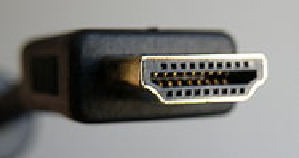Hardware Reference
In-Depth Information
High-Defi nition Multimedia Interface (HDMI)
is an even newer digital video interface.
DVI and HDMI share some specifi cations, but HDMI doesn't have the four analog pins
for VGA compatibility (see Figure 3.5). HDMI also carries digital audio as well as video.
HDMI is used most often for television and home theatre components; it isn't commonly
used on personal computers as of this writing.
FIGURE 3.5
HDMIconnector
Photo by Alexey Goral
Adjusting a Monitor
When you change the monitor resolution (via the display driver properties in the Control
Panel in Windows, for example), the onscreen image may shift in one direction or become
slightly larger or smaller than it was before. Most monitors have onscreen controls that can
be used to adjust the image size, image position (known as
phase
when referring to left-
right positioning), contrast, brightness, and other factors. Check the monitor's manual to
fi gure out how the controls work; they're different for each model.
Inexpensive or old CRTs may have just a couple of thumbwheels or knobs for monitor
adjustment; newer and more sophisticated monitors will have a complete digital menu
system of controls that pop up when you press a certain button. You then move through the
menu system by pressing buttons on the monitor or moving a wheel or stick on the front or
back of the monitor.
On a CRT, there may be a
Degauss
button. You press this button to
discharge a built-up magnetic field within the monitor that may be causing
the picture to be distorted. LCDs don't have this problem, so they don't
have a Degauss feature. It's named after Carl Friedrich Gauss, a researcher
who studied magnetism.
On a notebook PC's built-in monitor, adjustment controls may be more basic. You're
likely to fi nd certain keys on the keyboard with extra symbols in a contrasting color.
Pressing these keys in combination with the Fn key activates that special function. For
example, there may be a key with a picture of the sun with an up arrow that increases the
display brightness. Consult the notebook PC's manual to learn the various meanings of
the Fn function keys.





















